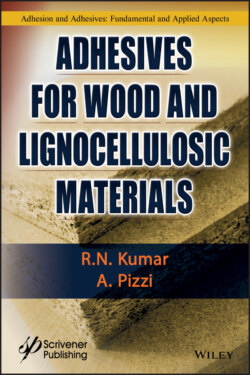Читать книгу Adhesives for Wood and Lignocellulosic Materials - R. N. Kumar - Страница 19
1.3.1.3 Organization of Cell Walls in Wood
ОглавлениеThe fiber ultrastructure is the hierarchic level ranging from the molecular level up to the fiber cell wall layers. The structure of the actual wood cell wall is very complex.
Under strong magnification, the visible height of various layers can be recognized in the wood cell wall. A clear demarcation between the individual layers can be seen with an electron microscope. With the aid of an electron microscope, the current knowledge of the structural composition of the wood cell walls was obtained between 1950 and 1970 [11].
For a clear understanding of the cell wall structure of wood, one should recognize the basic structural units, namely, fibrils, elementary fibrils, and microfibrils. They are described below:
The cellulose molecules are linear and can exhibit a high degree of lateral order, and they are therefore capable of forming strong intra- and intermolecular hydrogen bonds and aggregated bundles of molecules. Thus, the cellulose molecular chains can be organized into strands called fibrils. In the literature, these bundles of cellulose molecules have been given many different names, such as elementary fibrils, microfibrils, protofibrils, etc. [12–14]. The term cellulose microfibrils will be used in this book. These cellulose microfibrils have crystalline and amorphous regions.
Elementary fibrils are cellulosic strands of smallest possible diameter (35 Å). An elementary fibril of this cross-sectional dimension could contain about 40 cellulose chains. Aggregates of elementary fibers are classed as microfibrils and occur in nature in a broad spectrum of sizes depending on the source of lignin. They are probably 100 to 300 Å wide and evidently of indefinite length. Microfibrils aggregate into larger units called macro-fibrils and they are joined into lamellae that are organized into cell wall layers [11].
Each elementary fibril contains about 40 cellulose chains, 20–60 elementary fibrils are fasciculated to form a microfibril, and about 20 microfibrils form a macrofibril.
The cell walls of wood are made up of oriented cellulose microfibrils embedded in a matrix of lignin and hemicelluloses. They are highly structured layers that are arranged concentrically and are formed at different periods during cell differentiation. Between the cells is the region called middle lamella, which ensures adhesion between adjacent cells and is made up of pectic substances and lignin [15].
The primary wall: Attached to the middle lamella is the primary cell wall (0.1 mm), which has a randomly oriented, loose weaving of microfibrils. This wall is very thin and does not show the lamellation observed in the secondary wall. The primary wall is the first layer deposited during the development of the cell and provides the framework for the subsequent formation of the secondary wall.
In the secondary wall, the microfibrils are closely packed. The amount of lignin is low (10–20%), and cellulose content ranged from about 50% to over 60%. The secondary wall is formed of three distinct layers, the S1, S2, and S3 layers; each layer is much thicker than the primary wall (Figure 1.2). This is the principal structural element of the wood cell with the microfibrils aligned helically around the lumen. The degree of orientation of the microfibrils and the proportions of the various layers in the cell wall determine the properties of the cell. This is the most important layer in terms of mechanical properties.
Figure 1.2 Schematic model of the cell wall layers [16].
The S1 layer is thin and consists of a few lamellae. It has a crossed microfibrillar texture, with its lamellae exhibiting an alternating left-hand and right-hand helical arrangement. In each lamella, the helical angle is about 50–90°, as measured from the longitudinal axis of the cell.
The S2 layer is thick, especially in latewood tracheids and thick-walled fibers. It is composed of 30–150 lamellae. Adjoining lamellae are observed to exhibit a similar (not crossed) microfibrillar orientation. The microfibrils show a high degree of parallelism in all lamellae, and they run approximately parallel to cell axis, usually not exceeding an angle of about 30°. Typically, the S2 layer, whose microfibrils are oriented nearly parallel to the long axis of the cell, is responsible for resisting the principal stresses in the living tree and for the high longitudinal strength and stiffness of lumber cut from the tree. Thick S2 layers of latewood cells are considered as the reason for their resistance to stresses parallel to the long axis of the cell.
The S3 layer is usually thinner than the S1 and it is lamellate (up to six lamellae). The angle of microfibrils likewise varies from about 50° to 90°. The S3 layer may sometimes be missing.
The warty layer may line the lumina and pit cavities of tracheids, fibers, and vessels of many softwoods and hardwoods. This layer is attached to the S3 layer, and may occur on top of spiral thickenings. The warty layer forms during the final stages of cell wall development, and it is regarded as a structure arising from the dying protoplasm (deposited by the living protoplasm prior to its degeneration). The major chemical component of warts is lignin; hemicelluloses are also present.
Unlike the lumen, which is a void space, the cell wall has a highly regular structure, differing in nature from one cell type to another and also vary between species, and even within the same softwood and hardwood species.
Various electron microscopic observations gave rise to the model of the construction of wood cell walls as shown in Figure 1.2 [5].
